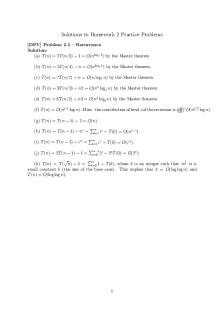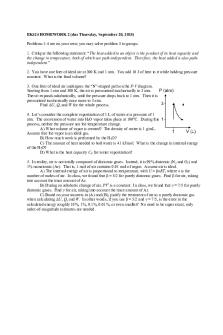Hw2 practice solutions PDF

| Title | Hw2 practice solutions |
|---|---|
| Author | Moonsu Kang |
| Course | Graduate Algorithms |
| Institution | Georgia Institute of Technology |
| Pages | 2 |
| File Size | 55.2 KB |
| File Type | |
| Total Downloads | 12 |
| Total Views | 135 |
Summary
Download Hw2 practice solutions PDF
Description
Solutions to Homework 2 Practice Problems [DPV] Problem 2.5 – Recurrence Solution: (a) T (n) = 2T (n/3) + 1 = O(nlog3 2 ) by the Master theorem. (b) T (n) = 5T (n/4) + n = O(nlog4 5 ) by the Master theorem. (c) T (n) = 7T (n/7) + n = O(n log7 n) by the Master theorem. (d) T (n) = 9T (n/3) + n2 = O(n2 log3 n) by the Master theorem. (e) T (n) = 8T (n/2) + n3 = O(n3 log2 n) by the Master theorem. 49 i ) O(n3/2 log n). (f) T (n) = O(n3/2 log n). Hint: the contribution of level i of the recursion is (125
(g) T (n) = T (n − 1) + 2 = O(n). (h) T (n) = T (n − 1) + nc = (i) T (n) = T (n − 1) + cn = (j) T (n) = 2T (n − 1) + 1 =
Pn
i=1
Pn
i=1
ci + T (0) = O(cn ).
Pn−1 i=0
ic + T (0) = O(nc+1 ).
2i + 2n T (0) = O(2n ).
Pk 1 √ (k) T (n) = T ( n) + 1 = i=0 1 + T (b), where k is an integer such that n2k is a small constant b (the size of the base case). This implies that k = O(log log n) and T (n) = O(log log n).
1
[DPV] Problem 2.7 – Roots of unity Solution: For the sum, use the geometric series equality to get 1 + ω + ω 2 + · · · + ω n−1 = For the product, since 1 + 2 + · · · + (n − 1) =
ωn − 1 = 0. ω−1
(n−1)n 2
1ωω 2 . . . ωn−1 = ω
we get
(n−1)n 2
n
which equals 1 if n is odd and ω 2 = −1 for n even (remember that ω = e
2πi n
).
[DPV] Problem 2.14 – Duplicates Solution: This is a straight forward application of the MergeSort algorithm. STEP1: Sort the given list. The running time of this step is O(n log (n)). STEP2: For i = 1 to n − 1: if ai = ai+1 , delete ai from the list. Output the final list. This list has no repeated terms. The running time of this step is O(n). Why the algorithm is correct: the list after step 1 is sorted, so if there are repeated terms of aj for some j, they are all consecutive. STEP2 guarantees a comparison of all elements with both of its neighbors and elimination of one of the copies every time we found one. Hence no copies survived after STEP2 is completed. The running time is O(n log (n) + n) = O(n log (n)). (Alternatively, you can modify the Merge subroutine to eliminate copies at the same time that the merging is done.)
2...
Similar Free PDFs

Hw2 practice solutions
- 2 Pages

HW2 solutions
- 6 Pages

8010 hw2 solutions
- 3 Pages

Hw-2 sol - hw2 solutions
- 7 Pages

EK424 HW2+solutions - Fall 2018
- 6 Pages

6414 HW2 Peer Solutions SP2021
- 9 Pages

Hw2 solutions - hw 2 solu
- 4 Pages

HW2 Fin305 - HW2
- 3 Pages

Hw2 solution - hw2
- 5 Pages

HW2
- 12 Pages

Practice Solutions
- 71 Pages

HW2 - gfhfghfgh
- 4 Pages

Hw2 solution
- 5 Pages

HW2 solution
- 19 Pages
Popular Institutions
- Tinajero National High School - Annex
- Politeknik Caltex Riau
- Yokohama City University
- SGT University
- University of Al-Qadisiyah
- Divine Word College of Vigan
- Techniek College Rotterdam
- Universidade de Santiago
- Universiti Teknologi MARA Cawangan Johor Kampus Pasir Gudang
- Poltekkes Kemenkes Yogyakarta
- Baguio City National High School
- Colegio san marcos
- preparatoria uno
- Centro de Bachillerato Tecnológico Industrial y de Servicios No. 107
- Dalian Maritime University
- Quang Trung Secondary School
- Colegio Tecnológico en Informática
- Corporación Regional de Educación Superior
- Grupo CEDVA
- Dar Al Uloom University
- Centro de Estudios Preuniversitarios de la Universidad Nacional de Ingeniería
- 上智大学
- Aakash International School, Nuna Majara
- San Felipe Neri Catholic School
- Kang Chiao International School - New Taipei City
- Misamis Occidental National High School
- Institución Educativa Escuela Normal Juan Ladrilleros
- Kolehiyo ng Pantukan
- Batanes State College
- Instituto Continental
- Sekolah Menengah Kejuruan Kesehatan Kaltara (Tarakan)
- Colegio de La Inmaculada Concepcion - Cebu

